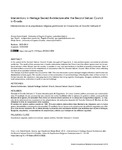Mostrar o rexistro simple do ítem
Interventions in Heritage Sacred Architecture after the Second Vatican Council in Croatia
| dc.contributor.author | Sokol-Gojnik, Zorana | |
| dc.contributor.author | Gojnik, Igor | |
| dc.contributor.author | Banić, Marija | |
| dc.date.accessioned | 2020-04-21T11:27:50Z | |
| dc.date.available | 2020-04-21T11:27:50Z | |
| dc.date.issued | 2020 | |
| dc.identifier.citation | Sokol-Gojnik, Zorana, Igor Gojnik, y Marija Banić. 2019. «Intervenciones En La Arquitectura Religiosa Patrimonial En Croacia Tras El Concilio Vaticano II». Actas De Arquitectura Religiosa Contemporánea 6 (diciembre), 114-29. https://doi.org/10.17979/aarc.2019.6.0.6232 | es_ES |
| dc.identifier.issn | 2340-5503 | |
| dc.identifier.uri | http://hdl.handle.net/2183/25380 | |
| dc.description.abstract | [Resumen] Durante el Concilio Vaticano II, Croacia formaba parte de Yugoslavia. Un nuevo sistema político promovió una cosmovisión atea. El resultado de ese proceso fue una relación de mutua hostilidad entre la Iglesia y el gobierno oficial, y una profunda división de la Iglesia y la sociedad. Esto derivó en intervenciones extrañas en el campo de la arquitectura sagrada. La mayoría de las intervenciones ocurrieron en las adaptaciones de santuarios después del Concilio Vaticano II. Muchas de ellas reflejaban la falta de cooperación entre expertos. El cambio del sistema político ocurrió en 1990. El nuevo sistema democrático trajo libertad a las religiones, pero la nueva guerra desestabilizó nuevamente a la sociedad. El resultado fue un boom en la construcción de edificios sagrados que refleja la crisis de ese momento. En la última década, la situación está cambiando debido a las iniciativas que reúnen a teólogos, liturgistas, arquitectos, conservadores de arquitectura y artistas que trabajan en los edificios sagrados. | es_ES |
| dc.description.abstract | [Abstract] In the period of the Second Vatican Council Croatia was part of Yugoslavia. A new political system promoted an atheistic worldview. The result of that process was a hostile relationship between the Church and the official government and a profound division of the Church and the society. It resulted in very rare interventions in the field of sacred architecture. Most of the interventions occurred in the adaptations of sanctuaries after the Second Vatican Council. Most of them were reflecting the lack of co-operation between experts. The change of political system has occurred in 1990. The new democratic system brought religions freedom but the new war destabilized society again. The result is a boom in the construction of sacred buildings reflecting the crisis of that moment. In the last decade, the situation is changing due to the initiatives that bring together theologians, liturgists, architects, architectural conservators, and artists in work on sacred buildings. | es_ES |
| dc.language.iso | eng | es_ES |
| dc.publisher | Universidade da Coruña | es_ES |
| dc.relation.uri | https://doi.org/10.17979/aarc.2019.6.0.6232 | es_ES |
| dc.rights | Atribución-NoComercial 4.0 España | es_ES |
| dc.rights.uri | http://creativecommons.org/licenses/by-nc/3.0/es/ | * |
| dc.subject | Sacred architecture | es_ES |
| dc.subject | Cultural heritage | es_ES |
| dc.subject | Catholic church | es_ES |
| dc.subject | Second Vatican Council | es_ES |
| dc.subject | Croatia | es_ES |
| dc.subject | Arquitectura sagrada | es_ES |
| dc.subject | Patrimonio cultural | es_ES |
| dc.subject | Iglesia católica | es_ES |
| dc.subject | Concilio Vaticano II | es_ES |
| dc.subject | Croacia | es_ES |
| dc.title | Interventions in Heritage Sacred Architecture after the Second Vatican Council in Croatia | es_ES |
| dc.title.alternative | Intervenciones en la arquitectura religiosa patrimonial en Croacia tras el Concilio Vaticano II | es_ES |
| dc.type | info:eu-repo/semantics/article | es_ES |
| dc.rights.access | info:eu-repo/semantics/openAccess | es_ES |
| UDC.journalTitle | Actas de Arquitectura Religiosa Contemporánea | es_ES |
| UDC.volume | 6 | es_ES |
| UDC.startPage | 114 | es_ES |
| UDC.endPage | 129 | es_ES |






